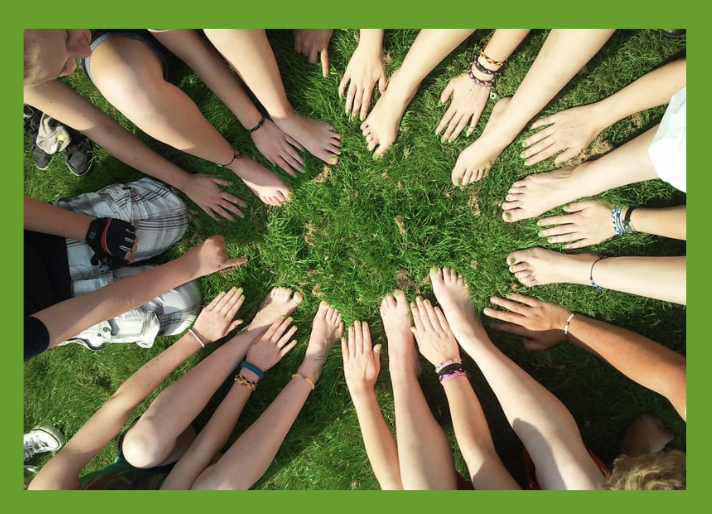Your Little World
I chaperoned my daughter’s third-grade field trip to the river parkway a couple of weeks ago. The river is an ideal setting to observe nature and explore habitats, providing a hands-on opportunity for 9-year-old ecologists to apply their skills. As budding scientists, the kids were given the task of observing.
“Look around you,” the docent said. “Notice what kinds of trees you see. Which one is the tallest? What are the main features of the landscape?”
The children eagerly explored the area, quickly pointing out the most noticeable features—because spotting the big things is always the easiest part.
Next, they were split into groups of 3-4 students and each group was given an embroidery hoop, a wooden circle about the size of a large dinner plate. Each group was instructed to find a place in this large landscape that would become their world. They would place the hoop on the ground, might be under a tree, or in the grass, wherever they decided, but then it had to stay there. This was their world.
Over the next 15 minutes, small groups of students studied their miniature worlds carefully, documenting the plants and animals (insects) that were in them. They gave their world a name. They drew pictures and used adjectives to write about this world. After they got tired of looking, they looked some more, and then they made up a story about what it would be like to live in that world. You have never seen someone be more excited about a plot of dry compacted dirt with some patchy grass! Sticks were given names, and the movement of the tiniest bug was tracked.
Watching these children closely observe their surroundings made me reflect on the work of fighting human trafficking. For so many of us, the first time we learned about human trafficking felt like a gut punch. How could this be happening so often in so many places? Some people feel overwhelmed and avoid learning more, fearing they can't handle the truth or that it demands a response they're not ready to give. Sometimes, even after we have been in the work for a long time, we hit a point where all we can see is brokenness and devastation. So many people are hurting and there just don’t seem to be enough healers.
“For so many of us, the first time we learned about human trafficking felt like a gut punch. How could this be happening so often in so many places?”
I think we all encounter a time in our own lives when the world just feels overwhelming. When we stand and look around, we see injustice everywhere. Just like the trees at the river parkway, big problems grab our attention, and it feels sometimes like they’re all around us. With global news at our fingertips, we are more aware than any previous generation of every war, every political upheaval, the faces of hungry children and bereaved mothers. What could we possibly do? How could we ever take care of all of this?
Of course, we can’t handle it all. We weren’t meant to. Instead, we take our cue from the third graders; we get up close and observe. We make the world smaller, noticing the life around us, the other people standing in our little part of the world who are also working towards justice and wholeness for themselves and others. We stopped to notice all we were missing, the beauty that exists right here, in this little circle. As we notice, we begin to tell the story of this smaller world. We learn the names of the people in places here, we share our own stories, we get up close and personal, learning to appreciate the dry dirt and the patches of grass and the ways they interact to create this little ecosystem and we begin to see how every movement we make here creates significant impact, maybe not for the faraway trees just yet, but for the pieces of this little world. Eventually, the water we place in this corner will reach the roots of those trees, which, it turns out, is the only way systemic change occurs.
When the 15 minutes were up at the river, each group partnered with another world power, and each team had to extoll the virtues of their miniature ecosystem. It wasn’t a competition, the docent explained. No one needed to convince someone that their world was better, simply help the other team see what you saw and return the favor, swapping places to learn about the next world.
“Before this activity,” the docent asked, “did you care about the part of the environment that became your world?”
Of course, they hadn’t. Of course, we don’t. We don’t even know it’s there until we get up close, and then we find we care deeply about it. We become connected to this little space, and we see the ways that we can impact it, whether on purpose or by accident, and the impact it has on us. We can spend all that time engaging in one tiny part of the world because our neighbors are doing the same thing in a different part. It would be too overwhelming to know everything about each little plot, but if my friends are experts in their world, then we can teach each other and work together to build a more complete picture. I can keep working in my tiny space, knowing that the space next to me is well cared for. Rather than being overwhelmed by the bigness of everything, I can be overjoyed by the nearness and the wonder of the small things up close.
If this season feels like too much, if the problems of the world are overwhelming, make your world small. Visit an art museum. Take cookies to a neighbor. Clean up a local park. Volunteer for a local organization. Stand alongside someone vulnerable and speak up when you see injustice happening. Donate. Mentor a teen. You make the world around you a better place and I’ll make the world around me a better place and when we gather together next, we will have such beautiful stories to share about our own ecosystem. Soon enough we’ll notice that the big trees are changing, too.


